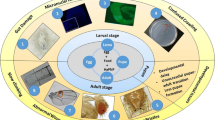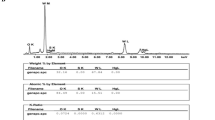Abstract
Zirconia nanoparticles (ZrO2 NPs) have been extensively used in teeth and bone implants and thus get a chance to interact with the physiological system. The current study investigated the oral administration of various concentrations of ZrO2 NPs synthesized by the hydrothermal method (0.25 to 5.0 mg L−1) on Drosophila physiology and behaviour. The size of the currently studied nanoparticle varies from 10 to 12 nm. ZrO2 NPs accumulated within the gut in a concentration-dependent manner and generate reactive oxygen species (ROS) only at 2.5 and 5.0 mg L−1 concentrations. ROS was detected by nitroblue tetrazolium (NBT) assay and 2′,7′-dichlorofluorescein (H2DCF) staining. The ROS toxicity alters the larval gut structure as revealed by DAPI staining. The NP stress of larvae affects the Drosophila development by distressing pupa count and varying the phenotypic changes in sensory organs (eye, thorax bristle, wings). Besides phenotypic changes, flawed climbing behaviour against gravity was seen in ZrO2 NP-treated flies. All together, for the first time, we have reported that a ROS-mediated ZrO2 NP toxicity alters neuronal development and functioning using Drosophila as a model organism.

ᅟ





Similar content being viewed by others
References
Aboushelib MN, Matinlinna JP, Salameh Z, Ounsi H (2008) Innovations in bonding to zirconia-based materials: part I. Dent Mater 24:1268–1272
Albanese A, Tang PS, Chan WC (2012) The effect of nanoparticle size, shape, and surface chemistry on biological systems. Annu Rev Biomed Eng 14:1–16
Al-Fahdawi MQ, Rasedee A, Al-Qubaisi MS, Alhassan FH, Rosli R, El Zowalaty ME, Naadja SE, Webster TJ, Taufiq-Yap YH (2015) Cytotoxicity and physicochemical characterization of iron–manganese-doped sulfated zirconia nanoparticles. Int J Nanomedicine 10:5739–5750
Arefian Z, Pishbin F, Negahdary M, Ajdary M (2015) Potential toxic effects of zirconia oxide nanoparticles on liver and kidney factors. Biomed Res 26:89–97
Armstrong N, Ramamoorthy M, Lyon D, Jones K, Duttaroy A (2013) Mechanism of silver nanoparticles action on insect pigmentation reveals intervention of copper homeostasis. PLoS One 8:e53186
Asadpour E, Sadeghnia HR, Ghorbani A, Sedaghat M, Boroushaki MT (2016) Oxidative stress-mediated cytotoxicity of zirconia nanoparticles on PC12 and N2a cells. J Nanopart Res 18:1–13
Barone MC, Bohmann D (2013) Assessing neurodegenerative phenotypes in Drosophila dopaminergic neurons by climbing assays and whole brain immunostaining. JoVE (J Vis Exp) e50339
Bokolia NP, Mishra M (2015) Hearing molecules, mechanism and transportation: modeled in Drosophila melanogaster. Dev Neurobiol 75:109–130
Brand AH, Perrimon N (1993) Targeted gene expression as a means of altering cell fates and generating dominant phenotypes. Development 118:401–415
Caicedo M, Jacobs JJ, Reddy A, Hallab NJ (2008) Analysis of metal ion-induced DNA damage, apoptosis, and necrosis in human (Jurkat) T-cells demonstrates Ni2+ and V3+ are more toxic than other metals: Al3+, Be2+, Co2+, Cr3+, Cu2+, Fe3+, Mo5+, Nb5+, Zr2+. J Biomed Mater Res A 86:905–913
Cant K, Knowles BA, Mooseker MS, Cooley L (1994) Drosophila singed, a fascin homolog, is required for actin bundle formation during oogenesis and bristle extension. J Cell Biol 125:369–380
Carinci F, Pezzetti F, Volinia S, Francioso F, Arcelli D, Farina E, Piattelli A (2004) Zirconium oxide: analysis of MG63 osteoblast-like cell response by means of a microarray technology. Biomaterials 25:215–228
Catelas I, Petit A, Zukor DJ, Marchand R, Yahia LH, Huk OL (1999) Induction of macrophage apoptosis by ceramic and polyethylene particles in vitro. Biomaterials 20:625–630
Clarke I, Manaka M, Green D, Williams P, Pezzotti G, Kim Y, Ries M, Sugano N, Sedel L, Delauney C (2003) Current status of zirconia used in total hip implants. J Bone Joint Surg 85:73–84
Claxton J (1969) Mosaic analysis of bristle displacement in Drosophila. Genetics 63:883–896
Culí J, Martín-Blanco E, Modolell J (2001) The EGF receptor and N signalling pathways act antagonistically in Drosophila mesothorax bristle patterning. Development 128:299–308
Depprich R, Zipprich H, Ommerborn M, Naujoks C, Wiesmann HP, Kiattavorncharoen S, Lauer HC, Meyer U, Kübler NR, Handschel J (2008) Osseointegration of zirconia implants compared with titanium: an in vivo study. Head Face Med 4:1–8
Di Virgilio A, Reigosa M, Arnal P, De Mele MFL (2010) Comparative study of the cytotoxic and genotoxic effects of titanium oxide and aluminium oxide nanoparticles in Chinese hamster ovary (CHO-K1) cells. J Hazard Mater 177:711–718
Fortini ME, Skupski MP, Boguski MS, Hariharan IK (2000) A survey of human disease gene counterparts in the Drosophila genome. J Cell Biol 150:23–30
Goodrich LV, Strutt D (2011) Principles of planar polarity in animal development. Development 138:1877–1892
Gupta SC, Siddique HR, Mathur N, Vishwakarma AL, Mishra RK, Saxena DK, Chowdhuri DK (2007) Induction of hsp70, alterations in oxidative stress markers and apoptosis against dichlorvos exposure in transgenic Drosophila melanogaster: modulation by reactive oxygen species. Biochim Biophys Acta 1770:1382–1394
Held LI (1991) Bristle patterning in Drosophila. BioEssays 13:633–640
Huang N, Yan Y, Xu Y, Jin Y, Lei J, Zou X, Ran D, Zhang H, Luan S, Gu H (2013) Alumina nanoparticles alter rhythmic activities of local interneurons in the antennal lobe of Drosophila. Nanotoxicology 7:212–220
Hussain S, Hess K, Gearhart J, Geiss K, Schlager J (2005) In vitro toxicity of nanoparticles in BRL 3A rat liver cells. Toxicol in Vitro 19:975–983
Karlsson HL, Cronholm P, Gustafsson J, Moller L (2008) Copper oxide nanoparticles are highly toxic: a comparison between metal oxide nanoparticles and carbon nanotubes. Chem Res Toxicol 21:1726–1732
Ko HC, Han JS, Bächle M, Jang JH, Shin SW, Kim DJ (2007) Initial osteoblast-like cell response to pure titanium and zirconia/alumina ceramics. Dent Mater 23:1349–1355
Kosmač T, Oblak C, Jevnikar P, Funduk N, Marion L (1999) The effect of surface grinding and sandblasting on flexural strength and reliability of Y-TZP zirconia ceramic. Dent Mater 1:426–433
Krebs RA, Feder ME (1997) Deleterious consequences of Hsp70 overexpression in Drosphila melanogaster larvae. Cell Stress Chaperones 2:60–71
Lacefield WR (1999) Materials characteristics of uncoated/ceramic-coated implant materials. Adv Dent Res 13:21–26
Lehane M (1997) Peritrophic matrix structure and function. Annu Rev Entomol 42:525–550
Lewinski N, Colvin V, Drezek R (2008) Cytotoxicity of nanoparticles. Small 4:26–49
Li Y, Fetchko M, Lai ZC, Baker NE (2003) Scabrous and Gp150 are endosomal proteins that regulate Notch activity. Development 130:2819–2827
Liang J, Deng Z, Jiang X, Li F, Li Y (2002) Photoluminescence of tetragonal ZrO2 nanoparticles synthesized by microwave irradiation. Inorg Chem 41:3602–3604
Lima EMCX, Koo H, Vacca Smith AM, Rosalen PL, Del Bel Cury AA (2008) Adsorption of salivary and serum proteins, and bacterial adherence on titanium and zirconia ceramic surfaces. Clin Oral Implants Res 19:780–785
Long TC, Saleh N, Tilton RD, Lowry GV, Veronesi B (2006) Titanium dioxide (P25) produces reactive oxygen species in immortalized brain microglia (BV2): implications for nanoparticle neurotoxicity. Environ Sci Technol 40:4346–4352
Lynch I, Dawson KA (2008) Protein-nanoparticle interactions. Nano Today 3:40–47
Manicone PF, Iommetti PR, Raffaelli L (2007) An overview of zirconia ceramics: basic properties and clinical applications. J Dent 35:819–826
Martinez V, Javadi C, Ngo E, Ngo L, Lagow R, Zhang B (2007) Age-related changes in climbing behavior and neural circuit physiology in Drosophila. Deve Neurobiol 67:778–791
Nagy LN, Mihály J, Polyák A, Debreczeni B, Császár B, Szigyártó IC, Wacha A, Czégény Z, Jakab E, Klébert S (2015) Inherently fluorescent and porous zirconia colloids: preparation, characterization and drug adsorption studies. J Mater Chem 3:7529–7537
Nagy LN, Polyák A, Mihály J, Szécsényi Á, Szigyártó IC, Czégény Z, Jakab E, Németh P, Magda B, Szabó PT (2016) Silica@zirconia@poly (malic acid) nanoparticle: a promising nanocarrier for theranostic applications. J Mater Chem B 4:4420–4429
Nichols CD, Becnel J, Pandey UB (2012) Methods to assay Drosophila behavior. JoVE (J Vis Exp) e3795
Ohlstein B, Spradling A (2006) The adult Drosophila posterior midgut is maintained by pluripotent stem cells. Nature 439:470–474
Pappus, S.A., Ekka, B., Sahu, S., Sabat, D., Dash, P., Mishra, M., 2017. A toxicity assessment of hydroxyapatite nanoparticles on development and behaviour of Drosophila melanogaster. Journal of Nanoparticle Research 19: 136
Piconi C, Maccauro G (1999) Zirconia as a ceramic biomaterial. Biomaterials 20:1–25
Posgai R, Cipolla-McCulloch CB, Murphy KR, Hussain SM, Rowe JJ, Nielsen MG (2011) Differential toxicity of silver and titanium dioxide nanoparticles on Drosophila Melanogaster development, reproductive effort, and viability: size, coatings and antioxidants matter. Chemosphere 85:34–42
Sabat D, Patnaik A, Ekka B, Dash P, Mishra M (2016) Investigation of titania nanoparticles on behaviour and mechanosensory organ of Drosophila melanogaster. Physiol Behav 167:76–85
Siddique YH (2012) Protective role of curcumin against the toxic effects of cyclophosphamide in the third instar larvae of transgenic Drosophila melanogaster (hsp70-lacZ) Bg9. Altern Med Stud 2:2–6
Sollazzo V, Palmieri A, Pezzetti F, Bignozzi CA, Argazzi R, Massari L, Brunelli G, Carinci F (2008) Genetic effect of zirconium oxide coating on osteoblast-like cells. J Biomed Mater Res 84:550–558
Song W, Onishi M, Jan LY, Jan YN (2007) Peripheral multidendritic sensory neurons are necessary for rhythmic locomotion behavior in Drosophila larvae. Proc Natl Acad Sci 104:5199–5204
Sotoudeh A, Jahanshahi A, Takhtfooladi MA, Bazazan A, Ganjali A, Harati MP (2013) Study on nano-structured hydroxyapatite/zirconia stabilized yttria on healing of articular cartilage defect in rabbit. Acta Bras Cir 28:340–345
Sponchia G, Ambrosi E, Rizzolio F, Hadla M, Del Tedesco A, Spena CR, Toffoli G, Riello P, Benedetti A (2015) Biocompatible tailored zirconia mesoporous nanoparticles with high surface area for theranostic applications. J Mater Chem 3:7300–7306
Takashima S, Hartenstein V (2012) Genetic control of intestinal stem cell specification and development: a comparative view. Stem Cell Rev 8:597–608
Tang S, Huang X, Chen X, Zheng N (2010) Hollow mesoporous zirconia nanocapsules for drug delivery. Adv Funct Mater 20:2442–2447
Tsakonas A, Rand S, Matthew D, Lake JR (1999) Notch signaling: cell fate control and signal integration in development. Science 284:770–776
Wason MS, Colon J, Das S, Seal S, Turkson J, Zhao J, Baker CH (2013) Sensitization of pancreatic cancer cells to radiation by cerium oxide nanoparticle-induced ROS production. Nanomed Nanotech Biol Med 9:558–569
Wolff T, Ready DF (1991) Cell death in normal and rough eye mutants of Drosophila. Development 113:825–839
Yang M, Hatton-Ellis E, Simpson P (2012) The kinase Sgg modulates temporal development of macrochaetes in Drosophila by phosphorylation of Scute and Pannier. Development 139:325–334
Zhang W, Yan Z, Li B, Jan LY, Jan YN (2014) Identification of motor neurons and a mechanosensitive sensory neuron in the defecation circuitry of Drosophila larvae. elife 3:e03293
Acknowledgments
We are thankful to S. Aurosman Pappus for his help in larva video tracking. We are thankful to Prof. Santanu Paria laboratory for zeta potential analysis of the sample and technical staff of NIT Rourkela for handling SEM and TEM facility.
Author information
Authors and Affiliations
Corresponding author
Ethics declarations
Funding
P. Unnikanan is thankful to DST-Inspire Fellowship for financial support.
Conflict of interest
The authors declare that they have no conflict of interest.
Rights and permissions
About this article
Cite this article
Mishra, M., Sabat, D., Ekka, B. et al. Oral intake of zirconia nanoparticle alters neuronal development and behaviour of Drosophila melanogaster . J Nanopart Res 19, 282 (2017). https://doi.org/10.1007/s11051-017-3971-y
Received:
Accepted:
Published:
DOI: https://doi.org/10.1007/s11051-017-3971-y




